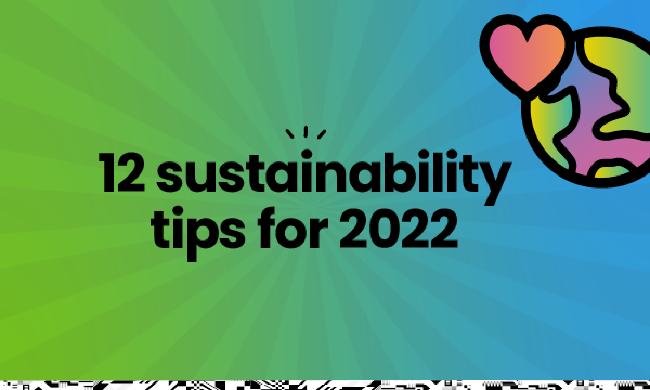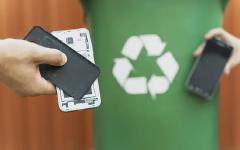Categories
A month by month guide to a more sustainable 2022
9 minute read

Thinking about the environment got you in a tizz, but don’t want to give up all the good things in life? Worry no longer. Living greener is not only easier than you think, it’s fun too. Follow our month-by-month guide for 2022 to discover simple things you can do to live more sustainably and reduce your carbon footprint.
January: think heating and insulation
It’s the dead of winter, so you can bet it’s going to be cold.
But this makes January the perfect time to get smart about your heating. If you haven’t already installed a smart meter, this should be your first step.
With smart thermostats you can control your heating from your mobile. So if you’re out longer than expected you can still turn your radiators off and save that energy, and some cash, too.
If you’ve got bog-standard heating, the ideal temperature for your living room is 18–21C if you’re fit and healthy. So, put an extra jumper on and see if you can keep it closer to 18C and still be comfortable.
To keep the heat in, a quick bit of insulation like a draught-excluder on your front and back doors can help. If you have an attic, make sure it’s well-insulated, but also don’t forget about the access hatch, as heat could be escaping there too.

February: get smart about mobile charging
Whether you’ve managed to pick up your dream phone in the January sales, or you’re still rocking your favourite model, now could be a good time to get into the habit of good battery hygiene.
Doing this will mean you won’t have to charge your phone as often; saving electricity and the environment.
- Don’t leave your mobile charging after it’s full. This will cause it to bounce between 99% and 100%, wasting energy. If your phone has an adaptive charging mode, make sure it’s switched on to avoid wasting energy when your phone is plugged in overnight.
- Change your background screen, screensaver and app displays to black, so long as this doesn’t affect its usability for you. Most batteries are used by the processor, but the second way it’s consumed is through the backlight. A more colourful screen, means more strain on your battery.
- Even after you’ve deleted them, apps leave a footprint, known as “orphaned files”, in your phone’s memory. Too many orphaned files can slow down your phone and waste energy. There are apps that delete these files. But if your phone is getting bogged down, it’s best to try a factory reset, then reinstall just the apps you need.
Note: A factory reset will wipe everything on your phone. So make sure any important files (photos, videos etc.) are backed up.
March: spring clean your wardrobe
Winter is coming to an end, meaning now’s a good time to rummage through your wardrobe and look for old clothes you don’t need.
If you find stuff you’re bored with, don’t just chuck it in the bin. Instead, consider upcycling it. Either donate it to a charity store or sell it online using apps like Vinted, DePop, hardlyeverwornit.com and eBay. You might even be able to find a local clothes swapping event, or a vintage clothes market who will buy certain items from you.
While you’re there, consider shopping sustainably for your spring wardrobe. With up to 20% of global water waste produced by the fashion industry, the environmental impact of your new clothes may be much higher than you think.
April: grow your own
Spring has sprung, which means it’s a good time to think about growing some of your own food.
This will obviously be a bit trickier if you don’t have a garden or allotment, but fear not, there’s still plenty of stuff you can grow.
Stick some herbs on the kitchen windowsill or a tomato plant in your bedroom window, or add a courgette plant to your balcony. Get creative with well-lit spaces and look for plants that prefer to grow indoors.
If you’ve got a garden, you’ll be surprised at how easy it is to find all sorts of seeds. Even larger supermarkets sell them, so keep your eyes peeled.
For beginners, salad leaves are a good bet as you can sew them regularly, meaning you’ll always get a new fresh crop coming.
May: do your DIY more sustainably
Hello, Bank Holiday weekends, and hello the perfect opportunities to spruce up your home in the sunshine.
If you’re thinking of painting, remember many paints contain chemicals known as Volatile Organic Compounds (VOCs), which release fumes while you’re painting as well as for many years afterwards. They can harm both you and the environment and your health, so try to avoid them and opt instead for eco-friendly paint made from naturally sourced ingredients.
Since these brands focus on sustainability, they may even sell their product in recycled packaging to minimise their carbon footprint. Another huge win for the environment.
June: join a beach or river clean-up
If you live near any of Britain’s 7,700 miles of coastline, joining (or better yet, starting your own) beach clean-up will help protect the natural beauty of your home, and it’s great exercise too.
You can find apps and websites to help you find a suitable place, such as those run by Surfers Against Sewage or the Marine Conservation Society. Your local authority or local environmental organisations may also run their own, too.
If you’re inland, you can still help by getting involved in litter-picking in your community, especially in rivers or canals which can carry plastic waste from many miles away.

July: opt for a greener holiday
COVID-19 has changed how we travel. Perhaps for the better. Airline emissions were down 67% in 2020 compared to 2019, with lower demand reducing the number of international flights. And that’s surely got us all thinking about how we can take a holiday without needing to travel by air.
So, the first step to a greener holiday is to look closer to home.
Then again, if you simply can’t resist the lure of faraway beaches and adventures, then aim to offset your travel. The World Wildlife Fund Carbon Footprint app in the App Store or on Google Play will help you to see the impact of your flights, while the Carbon Footprint & CO2 Tracker for Travel and Food on Google Play or in the App Store will allow you to offset your carbon emissions.
August: leave the car at home
Despite COVID-19 cutting car use by 24.7% (and increasing cycling to its highest rates since the 1960s), transport is still the largest source of greenhouse gas emissions.
As a nation, we are quite good when it comes to not using the car for trips of under a mile, but for 2 miles or more over two-fifths of people still use their car. If that sounds like you, try to get in the habit of leaving the car at home for these journeys, especially while the weather is warm.
Walk or invest in a bicycle and you’ll get some exercise too as well as cutting your carbon footprint.
Bonus point: short journeys aren’t great for your car either, because the engine oil never warms up to fully protect it, so you could also prolong the life of your car, further increasing sustainability.
September: rethink your food habits
After the summer’s glut of berries and other fresh produce, it’s worth thinking about your shopping habits.
Aim to avoid foods that travel long distances, as these will have large carbon footprints.
Also, avoid foods that are out of season, as these may require lots of extra water to produce.
Instead, think local and seasonal as what you buy will be at its best and will support farmers in your community.
Another way to make your diet more sustainable is to cut back on meat and dairy produce, even if only by one or two meals a week. According to Imperial College London, the carbon footprint of just one cheeseburger is equivalent to nine falafel meals.
October: swap to LEDs
As the evenings draw in and the clocks change, now’s the time to finally swap those old filament lightbulbs to LEDs.
While they produce the same amount of light, LEDs use far less electricity and they last longer, too. That’s good news for your bills as well as the environment.
According to the Energy Saving Trust, replacing a 50W halogen with an LED equivalent could cut your energy costs by £75 over the lifetime of the bulb. And that’s not including the price of all the replacement bulbs you’d need to buy along the way.
While you’ve got electricity on your mind, think about all those other appliances that get left on standby.
Lots of devices such as computers and games consoles still use power while switched off or in sleep mode. This, in the spirit of Halloween, is known as ‘vampire power’. They literally suck money right out of your pocket.
Make turning things off at the plug socket part of your nightly routine.
November: switch your energy to a green tariff
Winter is on its way, meaning if you’re not already on a green tariff, now’s the time to switch.
Some power providers generate their green energy with renewables like wind, tidal, solar and biomass, while others offset their carbon.
Energy comparison sites will usually let you compare green tariffs so you can see which offers best value for money.
December: have an eco-friendly Christmas
This Christmas, try to spend less on things and more on experiences.
That way, you’re minimising the risk of objects winding up in landfill. Just make sure the experiences you treat people to are eco-friendly.
Things such as forest adventures, wood cabin spas and outdoor sports like mountain biking and paragliding are all unforgettable, and won’t cost the earth.
If you absolutely must buy gifts, why not shop vintage? Pre-loved items can look just as good as new things if you wrap them up nicely enough.
Also, remember to use LED Christmas lights this year. They consume far less power. And if you opt for a live Christmas tree this year, try to get a rooted one that you can put outside in a pot and reuse the following year if possible. If not, see if you can take your tree to be chopped up for mulch, rather than tossing it away at the refuse centre.
Remember: small steps make a big difference
We all know how important it is to make more sustainable choices.
And while it can be tempting to try to do everything at once, the best strategy is actually to go step-by-step.
If you and your friends and family can make small, gradual and consistent changes, together we can all make a huge difference.
Hopefully, this guide will help you get started on your way to living a greener, more sustainable lifestyle. Just think, if you can make even one small change each month throughout 2022, you’ll be 12 times more eco-friendly by the end of the year.
Better yet, you’ll have plenty of fun along the way, with a new challenge to sink your teeth into each month.
Got some tips to share?
For additional eco-conscious ideas, or to share your own tips, be sure to check out our discussion on this topic in the giffgaff community.





